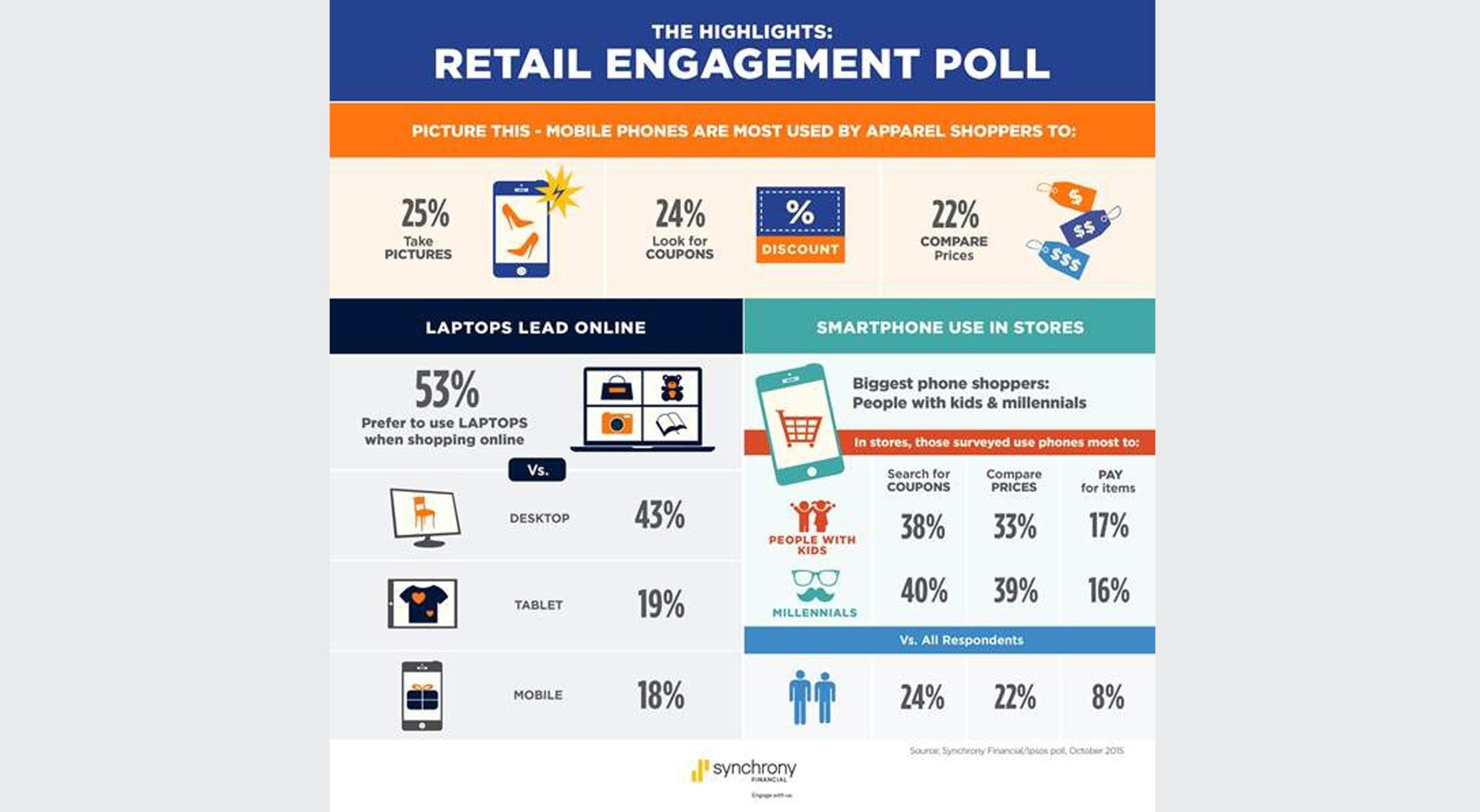White Paper
December 8, 2015, 10:15 AM EST
Shoppers' Little Helper: Mobile Tech
Author
Source: Reuters
Abstract:
Mobile technology supplements the in-store experience for shoppers in more ways than you may expect. Consumers continue to increase their use of smartphones and mobile devices when shopping in-store. In a recent Crowdtap poll* conducted by Synchrony Financial, more than 70 percent of Millennials and 67 percent of the Gen X shoppers surveyed report using their phones at least one time in their last five in-store trips.
And in a separate poll conducted for Synchrony Financial by Ipsos and Reuters Content Solutions, a majority of shoppers surveyed said they use their phone when shopping in-store to take pictures, look for coupons or compare prices. Phones in hand mean more ways to price shop; but retailers have begun to embrace this practice versus feeling threatened by it. Mobile technology is now seen as a part of the path to purchase both in-store and online.
When shopping online, consumers are using a number of devices to shop. Laptops are preferred by 53 percent followed by desktops at 43 percent and then tablets (19 percent) and phones (18 percent). Ownership of laptops continues to grow, while desktops are fading, albeit slowly.
Table of Contents
Mobile Tech at Work In-Store:
- Shoppers have more tools at their fingertips to find the best price, including price tracking tools and low-price guarantees.
- Some retailers are shifting to embrace shoppers’ “showrooming” tactics of investigating and trying out items in-store but not necessarily buying them there.
- Consumers increasingly take photos of items they’re interested in or have purchased and share them on social media.
Perhaps unsurprisingly, Millennials in the 18-to-34 age range were most likely to use their mobile phones to take photos of items while shopping, at 39 percent. Four out of 10 people in this youngest adult group say they would check for coupons or compare prices via their phones.
Boomers do the buying
While Millennials may be mobile-savvy shoppers, Boomers still account for most of the buying. A recent Nielsen report indicated that by 2017, adults over 50 will control 70 percent of all disposable cash in the United States. Millennial households have experienced a significant shift in total spending to educational expenses and, as a result, tend to be more frugal and shop where the rewards are greatest.
Millennials may be a sought-after segment, but they are not necessarily living large: “Millennials are thrifty, they have college debt, they work two or three jobs, they live at home,” says Bob Phibbs, CEO of the Retail Doctor consultancy in New York.
This validates why a multichannel experience is so important. Successful retailers are bridging the gap to please Boomers through channels they prefer—while seamlessly integrating mobile to capture a growing Millennial market with offers on products they’re interested in.
Phibbs says every retailer wants to figure out what the magic path to purchase might be, whether it’s through digital perks, like discount alerts or mobile information kiosks, or physical store enhancements like food areas or concierge offerings.
Crafting a unique experience
Showrooming plays an important role in this new mobile era. It allows consumers to truly experience a product and brand. And it provides retailers an opportunity to provide a unique interaction.
“A store is not a warehouse,” says Phibbs. “If it’s just, ‘We’ll make it quick for you,’ there’s nothing special about a brick-and-mortar store.”
A recent McKinsey report pointed out: “The wealth of online information available to consumers raises the bar for in-store service and expertise. But let’s be clear: the brick-and-mortar store is not dead, it just plays a different role now. In fact, in a multichannel world, physical stores can provide a competitive advantage.”
In this increasingly—but not ubiquitously—digital world, retailers must cater to in-store and online shoppers alike. Whether a Millennial or Boomer, a desktop user or mobile adopter, technology is changing the way shoppers browse and buy. Businesses that have mastered the online shopping experience as a supplement to their stores serve as fine examples of what the modern shopper wants today.
Retailers Put Innovation on Display
Here are just a few examples of innovative ways retailers are leveraging digital and trying to create a unique buying experience:
Rebecca Minkoff - Using technology powered by eBay, Rebecca Minkoff stores now feature a “connected wall” that lets shoppers browse clothing, view runway videos and even send clothing items of their choice to fitting rooms. Changing rooms have interactive features allowing shoppers to change lighting, contact sales staff and check out through mobile devices. A recent Fast Company article said the end goal for tech-integrated stores like Minkoff’s is to create “a store that mimics the shopping experience of a website or mobile app.”
Marc Jacobs - The luxury fashion retailer turned tweets and Instagram photos into dollars at a 2014 pop-up event at its Daisy fragrance store. Social posts with the hashtag #MJDaisyChain were redeemable for in-store credit, and the most creative post of each day netted a free handbag. The temporary store was able to leverage the posts to populate its social-media channels, drive awareness and build a fan base.
Nordstrom - Nordstrom’s app has a feature to see if the product, size and color you want are available in-store before you go. You can also pay for the item online and pick it up in-store. The app is integrated into MTL, interactive, and has reviews and feedback. There are also acquisition offers for downloading the app.
Old Navy - The Old Navy app offers an interactive shopping approach. Users can scan barcodes to find alternative sizes, colors and product details. They can also receive special discounts redeemable in-store or online.



